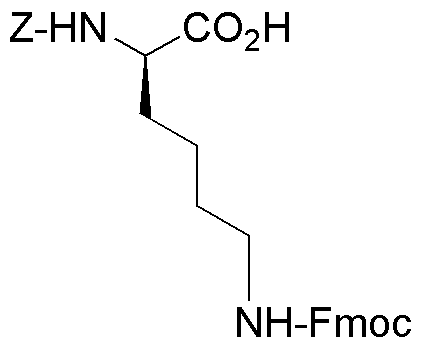Z-D-Lys(Fmoc)-OH is widely utilized in research focused on:
- Peptide Synthesis: This compound serves as a key building block in the synthesis of peptides, particularly in solid-phase peptide synthesis, allowing researchers to create complex peptide structures efficiently.
- Drug Development: It is used in the development of peptide-based drugs, providing a framework for modifying biological activity and improving therapeutic efficacy in pharmaceuticals.
- Bioconjugation: The compound aids in bioconjugation processes, where it can be linked to other biomolecules, enhancing the delivery and targeting of drugs in cancer therapy.
- Research in Neuroscience: It plays a role in studying neuropeptides, contributing to the understanding of neurological functions and potential treatments for neurological disorders.
- Protein Engineering: This chemical is instrumental in modifying proteins to study their functions, stability, and interactions, which is crucial for advancements in biotechnology and synthetic biology.
General Information
Properties
Safety and Regulations
Applications
Z-D-Lys(Fmoc)-OH is widely utilized in research focused on:
- Peptide Synthesis: This compound serves as a key building block in the synthesis of peptides, particularly in solid-phase peptide synthesis, allowing researchers to create complex peptide structures efficiently.
- Drug Development: It is used in the development of peptide-based drugs, providing a framework for modifying biological activity and improving therapeutic efficacy in pharmaceuticals.
- Bioconjugation: The compound aids in bioconjugation processes, where it can be linked to other biomolecules, enhancing the delivery and targeting of drugs in cancer therapy.
- Research in Neuroscience: It plays a role in studying neuropeptides, contributing to the understanding of neurological functions and potential treatments for neurological disorders.
- Protein Engineering: This chemical is instrumental in modifying proteins to study their functions, stability, and interactions, which is crucial for advancements in biotechnology and synthetic biology.
Documents
Safety Data Sheets (SDS)
The SDS provides comprehensive safety information on handling, storage, and disposal of the product.
Product Specification (PS)
The PS provides a comprehensive breakdown of the product’s properties, including chemical composition, physical state, purity, and storage requirements. It also details acceptable quality ranges and the product's intended applications.
Certificates of Analysis (COA)
Search for Certificates of Analysis (COA) by entering the products Lot Number. Lot and Batch Numbers can be found on a product’s label following the words ‘Lot’ or ‘Batch’.
*Catalog Number
*Lot Number
Certificates Of Origin (COO)
This COO confirms the country where the product was manufactured, and also details the materials and components used in it and whether it is derived from natural, synthetic, or other specific sources. This certificate may be required for customs, trade, and regulatory compliance.
*Catalog Number
*Lot Number
Safety Data Sheets (SDS)
The SDS provides comprehensive safety information on handling, storage, and disposal of the product.
DownloadProduct Specification (PS)
The PS provides a comprehensive breakdown of the product’s properties, including chemical composition, physical state, purity, and storage requirements. It also details acceptable quality ranges and the product's intended applications.
DownloadCertificates of Analysis (COA)
Search for Certificates of Analysis (COA) by entering the products Lot Number. Lot and Batch Numbers can be found on a product’s label following the words ‘Lot’ or ‘Batch’.
*Catalog Number
*Lot Number
Certificates Of Origin (COO)
This COO confirms the country where the product was manufactured, and also details the materials and components used in it and whether it is derived from natural, synthetic, or other specific sources. This certificate may be required for customs, trade, and regulatory compliance.


